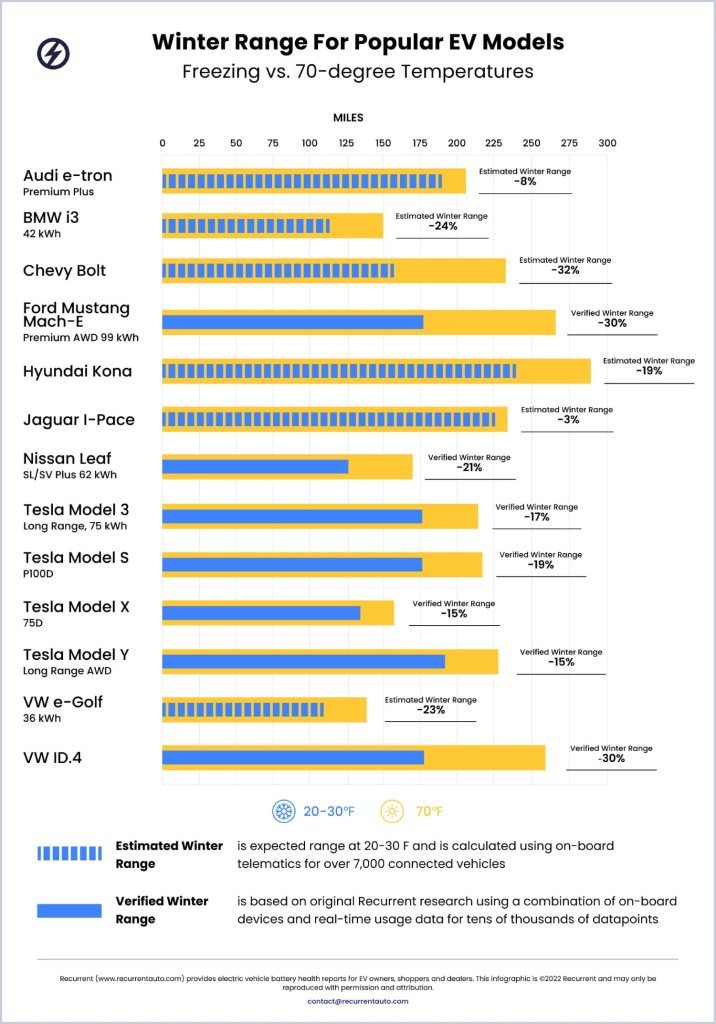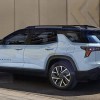
Electric Car Range Loss in Winter and Cold Weather up to 30% in Some Cases
All EVs see some range loss in cold weather; some examples are just more extreme than others. Research on electric car range loss in winter and cold weather found that some EVs could lose up to 30% of the original EPA-estimated range in 20 to 32°F temperatures. Check out some of the most popular electric vehicles on the market for 2022 and how the range held up in the cold.
Electric car range loss was as high as 30% in some popular EVs
According to a recent study from Recurrent, electric car range loss during the winter months isn’t something to overlook. There are two main reasons EVs have less range in the winter: mechanical and chemical. Chemical and physical reactions in the battery happen slower in cold temperatures, which reduces the electric vehicle’s power.
Secondly, electric cars have to make heat. In a traditional gas-powered vehicle, the extra heat from the engine can help heat the cabin. In an EV, an electric motor is much more efficient but doesn’t generate as much heat. The motor heat is used to warm the battery when the weather is cold. Warming the cabin also draws from the battery, which means there is less battery for actual driving.
However, all cars seem to react differently. Testing with a Ford Mustang Mach-E, Nissan LEAF, Volkswagen ID.4, and all of the Tesla models showed how electric vehicles respond differently.
Some electric car range loss can be attributed to how the cabin is heated

Recurrent compared 7,000 vehicles from across the US to see which brands and models were most susceptible to electric car range loss in the winter. Below are the 14 most popular options for 2022, but these are subject to change as more data arises.
The figures below come from “aggregated and anonymized data from 7,000 vehicles in the Recurrent community from across the United States as well as tens of thousands of data points from on-board devices that provide data on energy usage.”

Recurrent found that the Ford Mustang Mach-E and the Volkswagen ID.4 EV lost around 30% of its range during the winter. The Chevy Bolt lost an estimated 32% of its range in the winter weather, while the BMW i3 lost an estimated 24%.
For the Premium AWD Ford Mustang Mach-E, this electric SUV only achieved 65% of the EPA range in 20-30 degree temperatures. At 70 degrees, the Mach-E reached 93% of the range. Recurrent suggests that the range is significantly impacted since the Mach-E does not use a heat pump and relies on resistance heating. Energy is drawn from the battery to generate heat, which means fewer miles of range.
Be sure to take winter weather into consideration
The Volkswagen ID.4 with the 82 kWh battery has plenty of good features for cold weather. It comes available with all-wheel drive, a heated steering wheel, and remote preconditioning for the batter. The AWD version also comes with a heated windshield to make life easier.
Unfortunately, the cabin heater is resistive instead of using a heat pump. This drains the battery quicker than usual. Canadian and European versions have the option of a heat pump, but the US version is without. That left the observed range between 20 and 30 degrees at only 66% of the original EPA-estimated range. At 70 degrees, that increased to 94% of the range.
On the flip side, the Jaguar I-PACE EV only lost an estimated 3% of its winter range. At 70 degrees, the I-PACE achieved 100% of the original EPA range. The Jaguar EV doesn’t have the longest range, but it is apparently a good option for those in cooler climates. Check out the full study from Recurrent to see more electric car range loss numbers.



